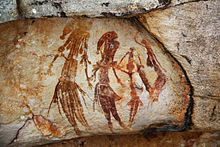Prince Regent National Park
| Prince Regent National Park | ||
|---|---|---|
| NASA image of Prince Regent National Park | ||
|
|
||
| Location: | Western Australia , Australia | |
| Specialty: | impassable, difficult to access area | |
| Surface: | 5764 km² | |
| Founding: | 1964 | |
The Prince Regent National Park (English: Price Regent National Park ) is a national park in the Kimberley region in northwestern Western Australia . The national park has been registered by UNESCO as the Prince Regent River Biosphere Reserve . It is recognized as an Important Bird Area together with the Mitchell River National Park bordering to the north .
This 5764 km² national park is one of the most remote areas in Australia , an area that has remained almost untouched by European settlement. Today it can only be reached by ship or plane.
Name and story of discovery
In 1820, the explorers went Phillip Parker King was the first European with his ship HMS Mermaid in the Prince Regent River , a he after the then Prince Regent George of Hanover, later King George IV of the United Kingdom of Great Britain and Ireland and King of Hanover to Names. Other names that refer to George IV are the St. George Basin , Hannover Bay and Braunschweig Bay .
The first settler to settle in the area was Joseph Bradshaw in 1890 and established the Marigui Homestead on the river. His agricultural endeavors were unsuccessful, but he discovered the early Bradshaw paintings , which got his name and are a form of rock painting of their own. There are said to be more than 100,000 specimens of these motifs in the Kimberley region, which are estimated to be more than 50,000 years old.
geography
The park extends over the water catchment area of the Prince Regent River . The Mitchell River National Park joins in the north of the park. The national park is far from human habitation, it is a wilderness. Access to the park is only possible by air or by boat. The coastal landscape is affected by a strong tidal range . Most tourists arrive in the national park on ships, most of which depart from either Broome or Darwin .
climate
The climate in the Kimberley region is characterized by heavy monsoon rains from October to March . Outside of these times, the area is almost rain-free and dry. Temperatures are high year round, ranging from 25 ° C to 35 ° C.
landscape
The park's landscape is characterized by rainforests and sandstone formations . The stone mountains and cliffs that loom in the landscape include the impressive Kings Cascades , Pitta Gorge , Mount Trafalgar and Python Cliffs . The water in the streams and rivers makes its way through numerous gorges and forms many waterfalls. There are numerous saltwater crocodiles and fish in the waters and in the coastal regions.
The traditional owners are the Aborigines of the Worora , who have a land right, the so-called Uunguu Native Title .
Flora and fauna
More than half of the mammals and birds in the Kimberley region live in this national park and more than 500 plant species have been counted. The national park has been registered by UNESCO as the Prince Regent River Biosphere Reserve . Due to its biodiversity, the national park is designated as the Prince Regent and Mitchell River Important Bird Area together with the Michell River National Park .
Web links
- Pictures from the national park
- World Database on Protected Areas - location map of the park (English)
Individual evidence
- ↑ a b Department of Parks and Wildlife 2013-14 Annual Report (PDF), p. 31, on parliament.wa.gov.au. Retrieved August 28, 2017.
- ↑ a b Australia's Biosphere Reserves , on environment.gov.au. Retrieved April 19, 2018.
- ↑ a b Prince Regent and Mitchell River , on datazone.birdlife. Retrieved August 19, 2017.
- ↑ a b Prince Regent National Park on australiaforeveryone.com.au. Retrieved August 19, 2017.
- ↑ North Western Australia , on worldwildlife.org. Retrieved August 19, 2017.
- ^ Prince Regent National Park , on parks.dpaw.wa.gov.au. Retrieved August 19, 2017.
- ↑ Goonack v State of Western Australia 2011 FCA 516 (23 May 2011) , dated May 23, 2011, at the Federal Court of Australia . Retrieved August 19, 2017.
- ↑ Wunambal Gaambera People , on wunambalgaambera.org.au. Retrieved August 19, 2017.


